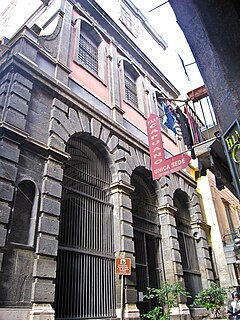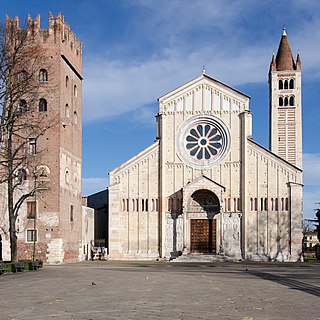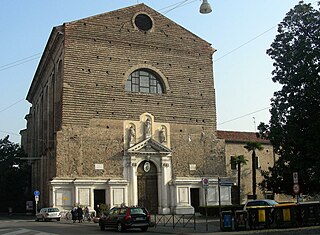This article includes a list of general references, but it lacks sufficient corresponding inline citations .(February 2020) |

San Daniele is a Roman Catholic church and monastery in Padua, region of Veneto, Italy.
This article includes a list of general references, but it lacks sufficient corresponding inline citations .(February 2020) |

San Daniele is a Roman Catholic church and monastery in Padua, region of Veneto, Italy.
The church and its adjacent monastery were built by 1076 by Benedictines affiliated with the Basilica of Santa Giustina di Padova. Legend holds that then Bishop Ulderico had organized a procession to transport the relics of St Daniel of Padua from the church of Santa Giustina to the Cathedral, but upon arriving to this spot, the relics became too heavy to carry, and a darkness with thunder and lightning supervened, and the bishop made a promise to build here a church to the holy martyr. [1] The saint is venerated as the deacon of Saint Prosdocimus, the first Bishop of Padua. San Daniele, sometimes labeled with the suffix "Levita", was said to have been a converted Jew who was martyred in the east in 168 A.D.
In 1771, the monastery was suppressed by the Republic of Venice, and transformed into a private residence. In 1948, Benedictine monks, exiled from a monastery in the former Yugoslavia, were housed in this monastery. The church is still consecrated; it was refurbished in a late-baroque style by the architect Francesco Muttoni. The facade and interior were extensively refurbished in the early 19th-century in a neoclassical fashion. The interior houses an altarpiece depicting the Birth of Jesus attributed to Palma il Giovane. In a 1795 guide, the first altarpiece on the left depicted a St Charles ministering to those afflicted with the plague by Giovanni Battista Bissoni. In addition, an altarpiece to the right had a canvas depicting a Crucifixion with Mary and St John the Baptist by Francesco Zanella. [2]
The antique wooden choir is protected by a metal railing. To the right of the church is an elevated terrace with views of the town and surroundings. [3]
The apse of the church still retains its circular apse partially derived from the previous Romanesque structure. The nave ceiling was frescoed in the 19th century by Sebastiano Santi, and depicts events related to St Daniele.

The Basilica di Santa Maria Gloriosa dei Frari, usually just called the Frari, is a church located in the Campo dei Frari at the heart of the San Polo district of Venice, Italy. The largest church in the city, it has the status of a minor basilica. The church is dedicated to the Assumption of Mary.

San Gregorio Armeno is a church and a monastery in Naples, Italy. It is one of the most important Baroque complexes in Naples. The church is located on a street of the same name just south of Via dei Tribunali and a few blocks south of the church of San Paolo Maggiore, Naples

Padua Cathedral, or Basilica Cathedral of Saint Mary of the Assumption, is a Roman Catholic minor basilica and the cathedral located on the east end of Piazza Duomo, adjacent to the Bishop's palace, in Padua, region of Veneto, Italy. The cathedral, dedicated to the Assumption of the Virgin Mary, is the seat of the bishop of Padua. The church building, first erected as seat of a bishop of the diocese in the 4th century, has undergone major reconstructions over the centuries.

The Basilica di San Zeno is a minor basilica of Verona, northern Italy constructed between 967 and 1398 AD. Its fame rests partly on its Romanesque architecture and partly upon the tradition that its crypt was the place of the marriage of Shakespeare's Romeo and Juliet. It stands adjacent to a Benedictine abbey, both dedicated to St Zeno of Verona.

San Francesco della Vigna is a Roman Catholic church in the Sestiere of Castello in Venice, northern Italy.

Piacenza Cathedral, fully the Cathedral of Santa Maria Assunta e Santa Giustina, is a Roman Catholic cathedral in Piacenza, Italy. The current structure was built between 1122 and 1233 and is one of the most valuable examples of a Romanesque cathedral in northern Italy. The dedication is to the Assumption of the Virgin Mary and to Saint Justina. It is the seat of the diocese of Piacenza-Bobbio.

The Abbey of Santa Giustina is a 10th-century Benedictine abbey complex located in front of the Prato della Valle in central Padua, region of Veneto, Italy. Adjacent to the former monastery is the basilica church of Santa Giustina, initially built in the 6th century, but whose present form derives from a 17th-century reconstruction.

Santa Sofia is the oldest Roman Catholic church structure in the city of Padua, region of Veneto, Italy. It was built in the 10th century on the site of a presumed Mithraeum. A grant was made to bishop Sinibaldo of this church in 1123, which had already been in construction. The Romanesque stone and brick facade was constructed from 1106 to 1127, but the semicircular apse may date from earlier. The interior is now relatively bare.

San Procolo is an early Gothic-style, Roman Catholic church and former monastery-hospital located on Via Massimo D'Azeglio #52 in central Bologna, region of Emilia Romagna, Italy.

The Basilica of San Fedele in Como is located in the city center and is dedicated to Saint Fidelis martyr. It derives from an earlier Christian church, dating from the seventh century, dedicated to Euphemia.

Praglia Abbey is a Benedictine monastery in the frazione of Bresseo in Teolo, Province of Padua, Italy. It is located at the foot of the Euganean Hills, some 12 kilometers southwest of Padua, and four kilometers from Abano Terme.

Santa Croce is a Roman Catholic church located on Corso Vittorio Emanuele 178 in Padua, Veneto region, Italy.

San Tommaso or San Tommaso in Pelleria is a Romanesque- style, Roman Catholic church located on Piazza of the same name in central Lucca, region of Tuscany, Italy.

The Abbey of St. Peter in Assisi, Italy, is inhabited by a small community of monks belonging to the Benedictine Cassinese Congregation. They live according to the Rule of St. Benedict, summarized as "Ora et Labora".

San Clemente, or St Clement, is a Baroque-style Roman Catholic church that overlooks the Piazza dei Signori in Padua, Italy. It is currently a dependent of the Cathedral Basilica of Santa Maria Assunta.

Santa Caterina d'Alessandria or Saint Catherine of Alexandria is a Roman Catholic church with a main facade on Piazza Bellini, and a lateral Western facade facing the elaborate Fontana Pretoria, in the historic quarter of Kalsa in the city of Palermo, region of Sicily, Italy. In front of the main facade, across the piazza Bellini, rise the older churches of San Cataldo and Santa Maria dell'Ammiraglio, while across Piazza Pretoria is the Theatine church of San Giuseppe and the entrance to the Quattro Canti. Refurbished over the centuries, the church retains elements and decorations from the Renaissance, Baroque, and late-Baroque (Rococo) eras. This church is distinct from the Oratorio di Santa Caterina found in the Olivella neighborhood.

Santa Tecla is the Baroque-style, Roman Catholic duomo or main church in the town of Este, province of Padua, region of Veneto, Italy.

The Basilica del Carmine is a 16th-century Roman Catholic church located on piazza Francesco Petrarca in Padua, region of Veneto, Italy. It was made a minor basilica in 1960 by pope John XXIII

Sant'Andrea is a Roman Catholic church located on Via Sant'Andrea in Padua, region of Veneto, Italy. Founded by the 12th-century as a parish church, the present church was completed in the late 19th century.

San Nicolò is a Romanesque and Gothic-style, Roman Catholic church in Padua, region of Veneto, Italy. It stands in front of a homonymous piazza, and is adjacent to the Palazzo Meschini and Palazzo Brunelli-Bonetti.
Coordinates: 45°24′03.78″N11°52′34.36″E / 45.4010500°N 11.8762111°E